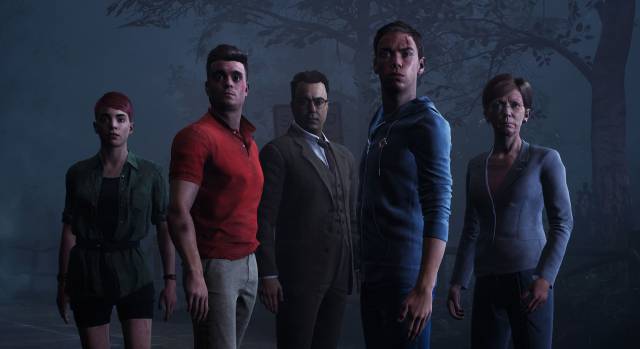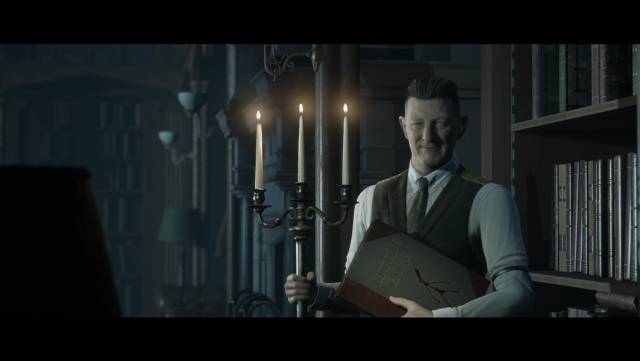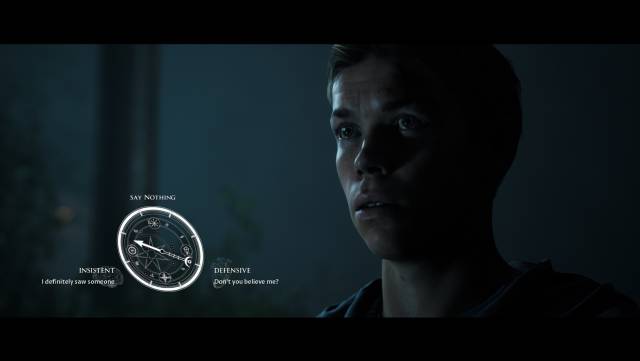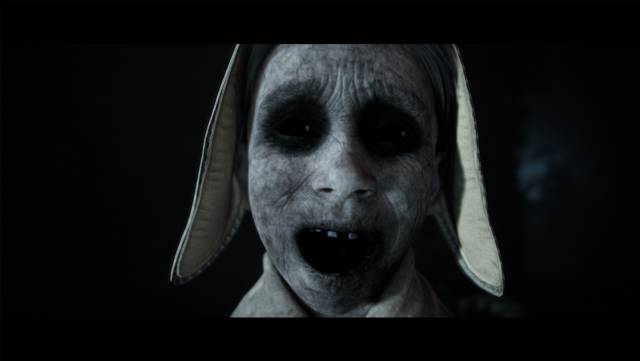
We enter the new Supermassive, an imperfect playable coven but well-cooked scares.
“Witchcraft is the sauce that idiots pour on failure to hide the taste of their incompetence”, from Clash of Kings (1998), George R. R. Martin
Whoever has already played the previous Man of Medan, already has an idea. But who does not know what the Dark Pictures Anthology is about, a brief summary: With Supermassive creating and developing and Bandai Namco producing and distributing, Dark Pictures is basically the translation of the concept of Tales from the Crypt or the (failed) Dark Universe of the Universal: different stories born from a gallery of paintings that a mysterious character, that curator of stories who is going to learn so much from us, discovers us.
From the sea to the mountains, from Medan to Little Hope

Each painting is a game, a title with a strong narrative load that, like each season of the American Horror Story series, will change the era, setting, characters, plot and sub-genre of terror in each installment. Last year we saw this ambitious anthology debut with Man of Medan, a title that took the concept of horror to the sea against a backdrop of ghost ships. This year, it’s time to change the scene, this year Supermassive has decided to change the sea for the mountains.
Like the previous one, the study wants to start from real events to build its own story. And Little Hope is part of the infamous Salem Trials, those in which a wave of Catholic-religious puritanism led many to their deaths on charges of witchcraft. The trials were real; real and unjust torture and deaths; And that’s the basis that Supermassive uses for its new title in its dark anthology.
“Give up all hope”
As often happens in these games, the less you know about the story the better. In fact we are going to give a small brushstroke, that if you do not want to read it and go to the next paragraph, even better: After the superb prologue, very similar to The Prophecy, the game starts with the typical beginning of a good horror movie, with a group of characters staying isolated in a place that seems abandoned at the beginning. A Middle Eastern American town called Little Hope, which in the middle of the Salem trials of 1692 had its share of prosecutors and witches.

And that’s it, here we stop, because the rest is better for you to discover for yourself. With a focus on works such as The Blair Witch Project, It Follows or La Bruja and with a very grateful ‘Horror Folk’ layer in the Silent Hill style – it starts as Downpour and has reminded us of the Dying Inside comic-, Supermassive composes a plot effective, surprising for its double temporal game and that you will be putting together piece by piece a bit because of what the characters tell and another because of the information you discover if you are curious and you like to explore. The commitment to a novel narrative structure is noticeable, finished off with an ending that will undoubtedly divide opinions.
Like Man of Medan, Little Hope’s campaign lasts about 4-5 hours. The funny thing is that the key in this sub-genre is the high replayability of the title – although the initial impact is clearly lost and most of the scares you already know. Divided into chapters, an improvement over Man of Medan is that the game starts directly and does not waste much time. In the previous one, the unnecessarily long character introduction took too long, and in the end it took almost half of its (short) duration to go to the ghost ship. But in Little Hope, we enter the story squarely, without hesitation. Although yes: as a good horror story, the first half is smooth, exploration pure and simple, and then in the second half it becomes a carousel of races, fights, escapes and QTE events.
Although the first game is a bit too small for you, being a game based on a ‘Branching’ system, Little Hope asks, demands, needs a second and even a third round, to choose alternative routes and experience different situations from those of your first return. The game succeeds in its visual planning, in how Supermassive places the cameras, and in its ration of being scared: there are many moments of tension when you think “it will scare me now, see you”, there are brilliantly executed scares, there are screaming and squirting for a nervous laugh. A good compendium, because we come to that, although sometimes there is a certain abuse of “BUH !!” to make you jump to the post.

The best thing is once again the inclusion of the Permadeath, and the saving of scenes that you will live every time a character dies. Depending on this you will see one end or another. And even though you don’t worry about the characters themselves, with the inclusion of permanent death the game makes you work hard not to lose them, although sometimes it won’t be so much your expertise solving QTEs as simply having made a random decision that was the correct one – it happened to us having a character suddenly in a decision to choose which side to go: one meets a monster, another with a partner and can flee.
The same gameplay
One of the dividing points in this type of game, the gameplay of Little Hope is the same as Man of Medan, although fine-tuned: there are parts in which we have total control over the movement of the character and we can also rotate the camera and the flashlight that you carry, in addition to interacting with the stage. We like that the camera has been improved, and now the game tells you what the button that asks you to press is for, and when a QTE will start with a vibration in the controller and the slowdown of the image.
The playable scheme uses few buttons, as it usually happens with these games: with the stick we move the character in the areas that allow us; with R2 – we have analyzed the game on a PS4 – we take objects, rotate them and examine them; with X we interact, with O we cancel; with L1 we walk fast; with the right stick we look and choose the decisions. We also have matches in QTE. And that’s it. If you played the previous one, you immediately take control of it. And get ready, because in the second part of the game the quicktime events are chained very quickly, although in general the pulse window in minigames such as the cardiogram has been expanded a bit.
Scares in Couple and 5

As in Man of Medan, Little Hope allows you to share your scares with a friend in an online cooperative that is a delight, because at times it separates you and leads you to travel different paths within the same campaign. If you play alone, depending on what you choose, it may take you one way or another. If you play Coop online, when the road forks, each one will play a specific zone. The fun is that by giving it a first spin in single player, we can replay it in Curator’s Cut mode, which allows us to experience that part that we did not see or only our partner saw.
Each of the 2 players can stop their game whenever they want, but beware, if you don’t warn the other and do so in the middle of a “delicate” moment, you can screw up the game. So in addition to scaring us off at Coop, Little Hope will offer us material for some ‘rage quit’ anthologies. Or rather ‘scare quits’, just like its predecessor
The third mode called Movie Night is also back, an extra mode that is based on the classic ‘pass the command’, but instead of going to a life, it is more fun: Designed for 5 players, Movie Night Mode is played at a command and with each player embodying one of the 5 characters. When it’s your turn, you take command and tackle your character’s part of the game, and then pass it on to your friend. The scares may be diluted between 5, but laughter and having a good time are guaranteed.
Photorealistic Muscle

At a visual level, the photorealism that the facial models of the game reach is impressive, something that is seen not only in the cinematics, but by opening the menu with R1 to be able to check it on the screen of the character you are wearing at that moment and their relationships. This is verifiable also in the objects that we examine or in the interior scenes. The downside is that the animations of the characters do not measure up to how good they look and it shows.
To highlight the enormous play of light and shadow that establishes the use of the flashlight, although it must be borne in mind that unlike Man of Medan, Little Hope is a very dark game from the beginning, with 80% in the dark and with barely lighting, so it does not shine outdoors like the previous one did. Something that we have loved is the improvement of the camera, which in narrow interior scenarios does not give as much war as before
At the execution level we have noticed fewer jerks, although there is a lip desynchronization at some moments that can take you out of the game. This time there are not so many problems with the initial loading of textures or jerks in the cinematics, but there are still them, surely derived from the load that the game is doing in the background. Although at least it’s not like in Man of Medan that they could screw you a QTE. The experience is more fluid, and that is appreciated.

In the sound section, we find an impeccable, superb Spanish dubbing with a great location, with professional voices that you hear in current series and movies. As for the soundtrack, Jason Graves shines again – he has played previous Supermassive works – with a score that rises above the usual, with moments that seem like homages to Jerry Goldsmith’s Ave Satani. The sound mix is chilling, enhancing the tension on the screen and helping the scare without a doubt. But sometimes 1-2 lines of dialogue of the characters speaking in English skip when we have the audio in Spanish denotes that there is something to correct there.
CONCLUSION
Correcting problems seen in their previous work and taking a (risky) somersault with the plot, it gives us the feeling that in Little Hope the Supermassive boys seem more comfortable telling the story, and they achieve moments of genuine terror and a tense atmosphere. But at the playable level there is practically nothing new, except that now they notify you when the QTEs are going to start. The game is short by the standards, but it packs a frightening and intense journey between specters and witches alongside replayability and priceless co-op and multi modes. If you didn’t like Man of Medan or if this kind of gameplay and gameplay isn’t your thing, then Little Hope isn’t going to like it either. But if you are a fan of these ‘interactive dramas’, there is nothing more ideal for this Halloween weekend, without a doubt.
THE BEST
- Again the online Coop mode and the Multi for 5 are great
- The great dubbing and the Score of Jason Graves
- The great use of vibration on the controller: now they notify you of QTEs
- It has very very effective scares (that is: frightening)
- The prologue, the plot with its parallel timelines and Supermassive’s risk of trying to innovate with the narrative structure
- Visually photorealism surprises …
WORST
- … Although it is a shame that the animations of the characters are not up to their facial modeling, too orthopedic at times
- Some graphic and sound bugs that should be fixed with a patch
- Occasional lip desynchronisations and abrupt transitions between scenes that are a bit unsettling.
Good
It meets the expectations of what a good game is, has quality and does not present serious flaws, although it is missing elements that could have taken it to higher levels.
